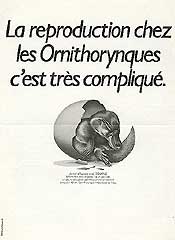Reproduction in Platypusses
is very complicated. It lives in Australia and Tasmania.
It is a mammal but lays eggs …
. Advertisement 5 is one of the very few where we
can learn something about the animal shown. The second page of the advert shows many copies
leaving the engine (the usual approach) under the header
With us reproduction is straightforward
.
This is the use of contrast but also a variation on the
better than Nature tune.
What I fail to understand is why the Platypus was choosen. The choice is appropriate, but other more
familiar species could perform equally well, I think. For that whiff of exotism perhaps ?
Black and White
copiers
became commonplace, boasted numerous functions and were followed by the first colour copiers.
The wonder of easy replication lost its charm. The time arrived when it was needed to stress colour and its quality.
The brand of example 6 announces its products by means of a Zebra. The black & white and
colour range of copiers are represented by the black & white and coloured half of a Zebra.
The text elaborates on the
incredibly sharp b&w half-tone images
and the
impact of colour for
more persuasive presentation materials and reports
.
(See also the chapter dedicated to
Zebras.)










